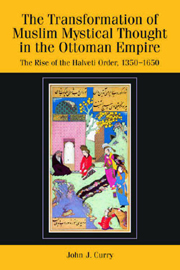 The Transformation of Muslim Mystical Thought in the Ottoman Empire
The Transformation of Muslim Mystical Thought in the Ottoman Empire Book contents
- Frontmatter
- Contents
- List of Maps and Figures
- Abbreviations for Frequently Cited Works in the Text
- Acknowledgments
- Note on Transliteration
- Map 1
- Map 2
- INTRODUCTION: ON THE STUDY OF OTTOMAN MYSTICAL TRADITIONS
- PART I THE RISE AND SPREAD OF THE HALVETİ ORDER FROM ITS ORIGINS THROUGH THE ELEVENTH/SEVENTEENTH CENTURY
- INTRODUCTION
- 1 EARLY SUFISM AND THE ORIGINS OF THE HALVETİ PATH, C. 900–1400
- 2 THE GREAT EXPANSION: FROM REGIONAL ORGANIZATION TO FAR-FLUNG NETWORK, C. 1400–1600
- PART II THE EVOLUTION OF A HALVETİ SUB-BRANCH: THE LIFE AND CAREER OF ŞAcBÂN-I VELİ AND HIS FOLLOWERS IN THE KASTAMONU REGION
- PART III DEFENDING THE CULT OF SAINTS IN ELEVENTH/SEVENTEENTH-CENTURY KASTAMONU: TRANSFORMING THE ŞAcBÂNİYE ORDER UNDER cÖMER EL-FUɔÂDÎ
- CONCLUSION: WHAT CAN THE ŞAcBÂNİYE TEACH US ABOUT TRANSITIONS IN THE EARLY MODERN PERIOD OF WORLD HISTORY?
- Appendix I
- Appendix II
- Works Cited and Further Reading
- Index of Persons
- Index of Places
- Index of Subjects
1 - EARLY SUFISM AND THE ORIGINS OF THE HALVETİ PATH, C. 900–1400
from PART I - THE RISE AND SPREAD OF THE HALVETİ ORDER FROM ITS ORIGINS THROUGH THE ELEVENTH/SEVENTEENTH CENTURY
Published online by Cambridge University Press: 12 September 2012
- Frontmatter
- Contents
- List of Maps and Figures
- Abbreviations for Frequently Cited Works in the Text
- Acknowledgments
- Note on Transliteration
- Map 1
- Map 2
- INTRODUCTION: ON THE STUDY OF OTTOMAN MYSTICAL TRADITIONS
- PART I THE RISE AND SPREAD OF THE HALVETİ ORDER FROM ITS ORIGINS THROUGH THE ELEVENTH/SEVENTEENTH CENTURY
- INTRODUCTION
- 1 EARLY SUFISM AND THE ORIGINS OF THE HALVETİ PATH, C. 900–1400
- 2 THE GREAT EXPANSION: FROM REGIONAL ORGANIZATION TO FAR-FLUNG NETWORK, C. 1400–1600
- PART II THE EVOLUTION OF A HALVETİ SUB-BRANCH: THE LIFE AND CAREER OF ŞAcBÂN-I VELİ AND HIS FOLLOWERS IN THE KASTAMONU REGION
- PART III DEFENDING THE CULT OF SAINTS IN ELEVENTH/SEVENTEENTH-CENTURY KASTAMONU: TRANSFORMING THE ŞAcBÂNİYE ORDER UNDER cÖMER EL-FUɔÂDÎ
- CONCLUSION: WHAT CAN THE ŞAcBÂNİYE TEACH US ABOUT TRANSITIONS IN THE EARLY MODERN PERIOD OF WORLD HISTORY?
- Appendix I
- Appendix II
- Works Cited and Further Reading
- Index of Persons
- Index of Places
- Index of Subjects
Summary
Modern historiographical theory leads most contemporary historians to be critical of origin myths for various Sufi orders that tie them back to revered founding figures in their respective traditions. Historians recognize that the search for legitimacy in subsequent periods led all manner of Sufi intellectuals to construct narratives by which they could link themselves to irrefutable sources of authority for their community. Thus, the Halveti silsile, which all Halveti shaykhs from the earliest times up to the present would cite as an authoritative document linking themselves and their doctrines back to the founding figures of Islamic tradition, might quickly be dismissed by modern historians as having little or no historical value. At the very least, most historians of the Islamic mystical tradition now argue that what came to be called Sufism began to form, at the earliest, only during the second/eighth century, and that the consolidation of Sufi orders themselves may only have begun centuries after the first Muslims had expanded out of the Arabian peninsula.
Be that as it may, historians must also recognize that the Halveti narratives about their origins maintain a remarkable continuity over time and place when they did begin to consolidate their narrative histories and set them down in written form. Whatever lack of historical truth the Halveti silsile embodies for modern critics, it does not detract from the fact that their narratives about their foundation and origins were quite meaningful to the Halveti shaykhs and their followers, and undergirded their claims to religious legitimacy in the context of the societies they inhabited.
- Type
- Chapter
- Information
- The Transformation of Muslim Mystical Thought in the Ottoman EmpireThe Rise of the Halveti Order, 1350–1650, pp. 21 - 49Publisher: Edinburgh University PressPrint publication year: 2010


